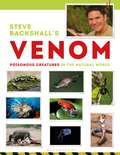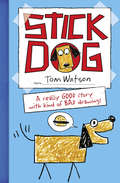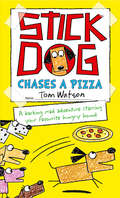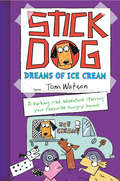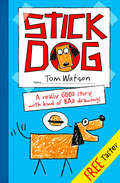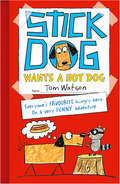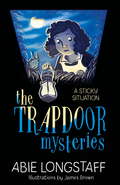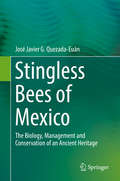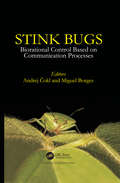- Table View
- List View
Steve Backshall's Venom
by Steve BackshallTV presenter Steve Backshall needs no introduction following his performances on TV series such as Deadly 60 and Lost Land of … This is a reformatted, redesigned edition of a popular title. Poison is an everyday part of the animal world, and an essential tool for hunting and defence. A wide variety of insects, reptiles and amphibians use toxins to subdue their prey or to stop becoming prey to another predator. Even some mammals and birds resort to poison as a means of securing a meal or deterring attack!From species such as the King Cobra, Lionfish, Fat-tail Scorpion and Poison Dart-frog to the diminutive but lethal Black Widow Spider, the author takes a fascinating look at the different types of natural venoms. On a tour of the world's continents, he looks at over 60 of the most venomous creatures, describing their main characteristics and explaining how they administer their venom and what its effects are. Stunning colour photographs and exciting accounts of Steve's own encounters with some of these animals bring the world of natural venom alive.
Steve Backshall's Venom
by Steve BackshallTV presenter Steve Backshall needs no introduction following his performances on TV series such as Deadly 60 and Lost Land of … This is a reformatted, redesigned edition of a popular title. Poison is an everyday part of the animal world, and an essential tool for hunting and defence. A wide variety of insects, reptiles and amphibians use toxins to subdue their prey or to stop becoming prey to another predator. Even some mammals and birds resort to poison as a means of securing a meal or deterring attack!From species such as the King Cobra, Lionfish, Fat-tail Scorpion and Poison Dart-frog to the diminutive but lethal Black Widow Spider, the author takes a fascinating look at the different types of natural venoms. On a tour of the world's continents, he looks at over 60 of the most venomous creatures, describing their main characteristics and explaining how they administer their venom and what its effects are. Stunning colour photographs and exciting accounts of Steve's own encounters with some of these animals bring the world of natural venom alive.
Stichwort: Wähler - Parteien - Wahlverfahren
by Wichard Woyke1. Das Recht zu wählen ist eines der wichtigsten verfassungsmäßigen Rechte des Bürgers und - neben -+ Abstimmungen - seine einzige Mög lichkeit, unmittelbar am politischen Prozeß teilzunehmen. Das Wahlrecht erhält der Bürger mit seiner Volljährigkeit, es zeichnet ihn als Bürger aus. Wähler - Parteien - Entscheidungen Durch Wahlen werden in Deutschland auf unterschiedlichen Ebenen - Europa, Bund, Länder und Gemeinden - Körperschaften (Repräsenta tionsorgane) gebildet oder Personen ermittelt, die ein Wahlamt - z.B. Bundestagsabgeordneter, Bürgermeister - ausüben. Meistens wird mit den Wahlen nicht nur eine Personalentscheidung getroffen, sondern gleichzeitig auch eine Sachentscheidung über politische Grundpositionen und Programme von Parteien und Wählervereinigungen. Bürgerinnen und Bürger nehmen mit ihrer Wahlentscheidung einen wich tigen Einfluß auf das politische Geschehen in ihrem Land und damit auf die Entwicklung der Gesellschaft, in der sie leben. Dieser Einfluß wird auch ausgeübt, wenn man nicht wählt. Denn die Mechanismen der Verteilung der abgegebenen Wählerstimmen (Stimmenverrechnung) werden stark von der Wahlbeteiligung (-+ 211) mitbestimmt. 2. Den Wählern gegenüber stehen die Parteien. Sie erfüllen eine herausra gende Funktion: Um in einem Staat mit ca. 80 Mio Einwohnern die vielen politischen Vorstellungen zu bündeln und geltend zu machen, sind Parteien oder Wählervereinigungen erforderlich. Sie haben sich deshalb im demo kratischen Staat zu unverzichtbaren Institutionen entwickelt. Sie nehmen die Rekrutierung des politischen Personals vor, stellen also Kandidaten für 11 Wahlämter auf, bündeln und artikulieren die gesellschaftlichen Interessen und bieten dem Wähler Alternativen.
Stick Dog (Stick Dog Ser. #1)
by Tom WatsonMeet Stick Dog – a new breed of hero! In his first adventure, Stick Dog and his friends embark on an epic quest to steal a hamburger. With hilarious illustrations and pitch-perfect humour, Stick Dog is a must-have for fans of WIMPY KID and BIG NATE.
Stick Dog (Stick Dog Ser. #1)
by Tom WatsonMeet Stick Dog – a new breed of hero! In his first adventure, Stick Dog and his friends embark on an epic quest to steal a hamburger. With hilarious illustrations and pitch-perfect humour, Stick Dog is a must-have for fans of WIMPY KID and BIG NATE.
Stick Dog Chases a Pizza: Stick Dog, Stick Dog Wants A Hot Dog, Stick Dog Chases A Pizza (Stick Dog Ser. #3)
by Tom WatsonStick Dog and his furry friends are BACK! In this third hilarious adventure, Stick Dog and his pals are out for a pizza! A must-have for fans of WIMPY KID and BIG NATE.
Stick Dog Dreams of Ice Cream: The Funniest, Hungriest Dog Is Back In Another Hilarious Adventure (Stick Dog Ser. #4)
by Tom WatsonEveryone’s favourite furry friends are BACK in this fourth hilarious adventure!
Stick Dog Taster (Stick Dog Ser. #1)
by Tom WatsonCheck out the first three chapters of this brilliant new book for FREE. Meet Stick Dog as he and his friends go on an epic quest to steal a hamburger. With hilarious illustrations and laugh-out humour, Stick Dog is a must-have for fans of WIMPY KID and BIG NATE.
Stick Dog Wants a Hot Dog: Stick Dog, Stick Dog Wants A Hot Dog, Stick Dog Chases A Pizza (Stick Dog Ser. #2)
by Tom WatsonStick Dog is back in his second hilarious and hugely illustrated adventure. This time he and his pals are hungry for hot dogs but they need a plan… a must-have for fans of WIMPY KID and BIG NATE.
A Sticky Situation: Book 1 (The Trapdoor Mysteries)
by Abie LongstaffThe first book in The Trapdoor Mysteries, a series about Tally, a code-breaking, animal-loving servant girl and her best friend, a squirrel named Squill, who solve mysteries with the help of a secret library...Ten-year-old Tally is a servant girl at Mollett Manor. She sleeps in the scullery sink, and spends her days scrubbing, polishing and ironing (when she's not secretly reading books). Then Tally and her squirrel friend, Squill, find a secret library hidden under the manor - a magical library where the books come to life! When Mollett Manor is burgled, can Tally use the knowledge she finds in the books to catch the criminals? Can they even help her solve the mystery of her missing mother?
The Sticky Synapse: Cell Adhesion Molecules and Their Role in Synapse Formation and Maintenance
by Michael Hortsch Hisashi UmemoriThe molecular mechanisms, which are responsible for the functional differences between the various types of neuronal synapses, have become one of the central themes of modern neurobiology. It is becoming increasingly clear that a misregulation of synaptogenesis and synaptic remodeling and dysfunctional neuronal synapses are at the heart of several human diseases, both neurological disorders and psychiatric conditions. As synapses present specialized cellular junctions between neurons and their target cells, it may not come as a surprise that neural cell adhesion molecules (CAMs) are of special importance for the genesis and the maintenance of synaptic connections. Genes encoding adhesive molecules make up a significant portion of the human genome, and neural CAMs even have been postulated to be a major factor in the evolution of the human brain. These are just some of the many reasons why we thought a book on neural CAMs and their role in establishing and maintaining neuronal synapses would be highly appropriate for summarizing our current state of knowledge. Without question, over the near future, additional adhesive proteins will join the ranks of synaptic CAMs and our knowledge, and how these molecules enable neurons and their targets to communicate effectively will grow.
A Sting in the Tale: My Adventures With Bumblebees
by Dave GoulsonA Sunday Times bestsellerShortlisted for the 2013 Samuel Johnson PrizeDave Goulson has always been obsessed with wildlife, from his childhood menagerie of exotic pets and dabbling in experimental taxidermy to his groundbreaking research into the mysterious ways of the bumblebee and his mission to protect our rarest bees.Once commonly found in the marshes of Kent, the short-haired bumblebee is now extinct in the UK, but still exists in the wilds of New Zealand, descended from a few queen bees shipped over in the nineteenth century. A Sting in the Tale tells the story of Goulson’s passionate drive to reintroduce it to its native land and contains groundbreaking research into these curious creatures, history’s relationship with the bumblebee, the disastrous effects intensive farming has had on our bee populations and the potential dangers if we are to continue down this path.
The Sting of the Wild
by Justin O. SchmidtEntomologist Justin O. Schmidt is on a mission. Some say it;€™s a brave exploration, others shake their heads in disbelief. His goal? To compare the impacts of stinging insects on humans, mainly using himself as the test case.In The Sting of the Wild, the colorful Dr. Schmidt takes us on a journey inside the lives of stinging insects. He explains how and why they attack and reveals the powerful punch they can deliver with a small venom gland and a "sting," the name for the apparatus that delivers the venom. We learn which insects are the worst to encounter and why some are barely worth considering. The Sting of the Wild includes the complete Schmidt Sting Pain Index, published here for the first time. In addition to a numerical ranking of the agony of each of the eighty-three stings he;€™s sampled so far, Schmidt describes them in prose worthy of a professional wine critic: "Looks deceive. Rich and full-bodied in appearance, but flavorless" and "Pure, intense, brilliant pain. Like walking over flaming charcoal with a three-inch nail embedded in your heel."Schmidt explains that, for some insects, stinging is used for hunting: small wasps, for example, can paralyze huge caterpillars for long enough to lay eggs inside them, so that their larvae emerge within a living feast. Others are used to kill competing insects, even members of their own species. Humans usually experience stings as defensive maneuvers used by insects to protect their nest mates. With colorful descriptions of each venom;€™s sensation and a story that leaves you tingling with awe, The Sting of the Wild;€™s one-of-a-kind style will fire your imagination.
The Sting of the Wild
by Justin O. SchmidtEntomologist Justin O. Schmidt is on a mission. Some say it;€™s a brave exploration, others shake their heads in disbelief. His goal? To compare the impacts of stinging insects on humans, mainly using himself as the test case.In The Sting of the Wild, the colorful Dr. Schmidt takes us on a journey inside the lives of stinging insects. He explains how and why they attack and reveals the powerful punch they can deliver with a small venom gland and a "sting," the name for the apparatus that delivers the venom. We learn which insects are the worst to encounter and why some are barely worth considering. The Sting of the Wild includes the complete Schmidt Sting Pain Index, published here for the first time. In addition to a numerical ranking of the agony of each of the eighty-three stings he;€™s sampled so far, Schmidt describes them in prose worthy of a professional wine critic: "Looks deceive. Rich and full-bodied in appearance, but flavorless" and "Pure, intense, brilliant pain. Like walking over flaming charcoal with a three-inch nail embedded in your heel."Schmidt explains that, for some insects, stinging is used for hunting: small wasps, for example, can paralyze huge caterpillars for long enough to lay eggs inside them, so that their larvae emerge within a living feast. Others are used to kill competing insects, even members of their own species. Humans usually experience stings as defensive maneuvers used by insects to protect their nest mates. With colorful descriptions of each venom;€™s sensation and a story that leaves you tingling with awe, The Sting of the Wild;€™s one-of-a-kind style will fire your imagination.
Stinging Insect Allergy: A Clinician's Guide
by Theodore M. Freeman James M. TracyThis comprehensive book thoroughly covers the field of stinging insect allergy; addressing all clinical aspects, including diagnosis and therapeutic recommendations. Stinging Insect Allergy: A Clinician’s Guide begins with a look into the entomologic aspects of Hymenoptera insects (bees, vespids, wasps and ants), which cause nearly all the IgE mediated reactions due to insects. Further chapters single out and examine the unique aspects of common Hymenoptera species, such as bees and fire ants, in rich detail. Later chapters clinically review what is known about non-Hymenoptera biting insects, such as mosquitoes. In addition, multiple chapters address the overlap of Hymenoptera allergy as practiced in North America and Europe, as well as other sciences. Final chapters cover the impact ecology is having on insect allergy; and the impact insect allergy is having on other areas of medicine, such as mast cell disorders. Stinging Insect Allergy: A Clinician’s Guide is an ideal resource for medical students, residents, allergists, and general practitioners alike, and also serves as an important reference text for any practitioner of allergy and immunology who desires a complete picture of Hymenoptera and non-Hymenoptera insect allergy.
Stingless Bees: Their Behaviour, Ecology and Evolution (Fascinating Life Sciences)
by Christoph GrüterStingless bees (Meliponini) are the largest and most diverse group of social bees, yet their largely tropical distribution means that they are less studied than their relatives, the bumble bees and honey bees. Stingless bees produce honey and collect pollen from tens of thousands of tropical plant species and, in the process, provide critical pollination services in the tropics. Like many other insects, they are struggling with new human-made challenges like habitat destruction, climate change and new diseases. This book provides an overview of stingless bee biology, with chapters on the evolutionary history, nesting biology, colony organisation and division of labour of stingless bees. In addition, it explores their defence strategies, foraging ecology, and varied communication methods. Accordingly, the book offers an accessible introduction and reference guide for students, researchers and laypeople interested in the biology of bees.
Stingless Bees of Mexico: The Biology, Management and Conservation of an Ancient Heritage
by José Javier Quezada-EuánThe stingless bees are the most diverse group of highly social bees and are key species in our planet’s tropical and subtropical regions, where they thrive. In Mexico, the management of stingless bees dates back centuries, and they were an essential part of the culture and cosmogony of native peoples like the Maya. In recent decades a vast amount of information has been gathered on stingless bees worldwide. This book summarizes various aspects of the biology and management of stingless bees, with special emphasis on the Mexican species and the traditions behind their cultivation. Much of the information presented here was produced by the author and the team of researchers at the Universidad Autónoma de Yucatán in the course of three decades of working with these insects. Given the breadth of its coverage, the book offers an equally valuable reference guide for academics, students and beekeepers alike.
Stinkbugs: Biorational Control Based on Communication Processes
by Andrej Cokl Miguel BorgesThis book presents an overview of the Pentatomidae species, covering their biology, phylogeny and reproductive behavior, main plants used in their diet and their nutritional exigencies, predatory stinkbugs, interactions between herbivores-plants and natural enemies, use of pheromone for monitoring phytophagous populations, and chemical and vibrational communication signals. It also presents possible technologies to be applied in field crops for pest management that could be developed as the basis of the interplay of stink bug communication signals.
Stinkbugs: Biorational Control Based on Communication Processes
by Andrej Čokl Miguel BorgesThis book presents an overview of the Pentatomidae species, covering their biology, phylogeny and reproductive behavior, main plants used in their diet and their nutritional exigencies, predatory stinkbugs, interactions between herbivores-plants and natural enemies, use of pheromone for monitoring phytophagous populations, and chemical and vibrational communication signals. It also presents possible technologies to be applied in field crops for pest management that could be developed as the basis of the interplay of stink bug communication signals.
